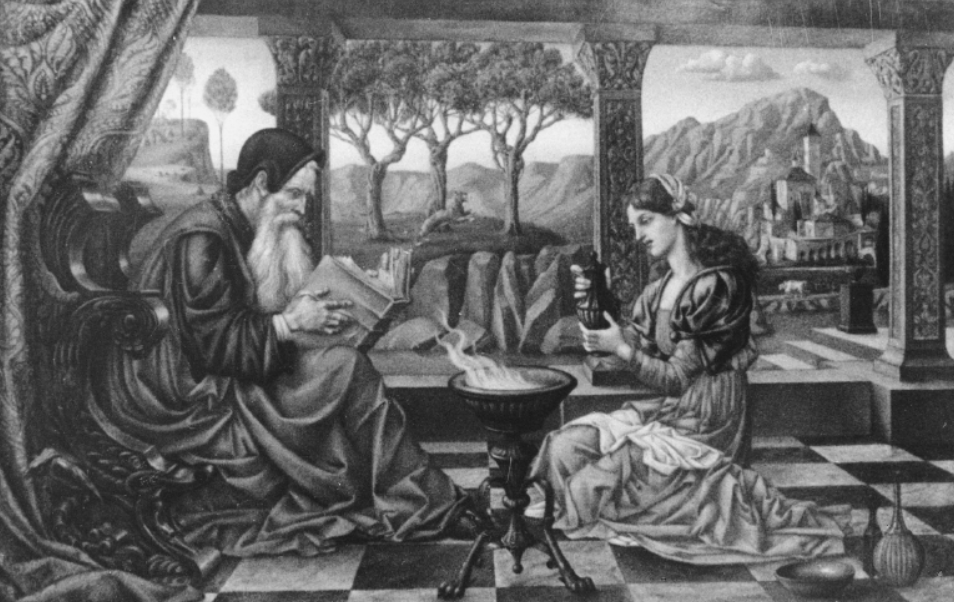The Love Potion is an oil painting by the English artist Evelyn De Morgan, created in 1903. It makes use of several of the medieval themes and stylistic devices favoured by the Pre-Raphaelites Group of English artists formed in 1848 to counter what they saw as the corrupting influence of the late-Renaissance painter Raphael., and can be seen as one of her series of allegorical paintings on the individual’s spiritual progression towards enlightenment.[1]
Group of English artists formed in 1848 to counter what they saw as the corrupting influence of the late-Renaissance painter Raphael., and can be seen as one of her series of allegorical paintings on the individual’s spiritual progression towards enlightenment.[1]
“The “dark, dangerous woman” was a particularly popular theme in late 19th-century art and literature,[2] but Evelyn portrays her sorceress as a scholarly, learned woman, surrounded by leather-bound volumes that point to her status as an alchemist.[3]
Although black cats The numerous folk beliefs about black cats, and cats in general, are often contradictory. Superstitions surrounding black cats are almost certainly some of the most prevalent even today, along with the number thirteen and walking under a ladder., such as the one sitting by the sorceress’s feet, are widely associated with witches, they were just one of the many animals that appear as familiars
The numerous folk beliefs about black cats, and cats in general, are often contradictory. Superstitions surrounding black cats are almost certainly some of the most prevalent even today, along with the number thirteen and walking under a ladder., such as the one sitting by the sorceress’s feet, are widely associated with witches, they were just one of the many animals that appear as familiars Demonic spirit who attends upon a witch, possessing magical powers that can be used for good or evil. Often taking the form of a small animal such as a cat. in confessions, and in this case it may be the colour black itself that is significant.[3] Among the volumes on display are works by Paracelsus and Agrippa Von Nettesheim, both 16th-century alchemists.[1] In the colour symbolism of alchemy, as promoted by Paracelsus, four colours – black, white, red and yellow – mark the progress of the spirit towards ultimate enlightenment. In The Love Potion these colours are arranged in a “tonal spiral” beginning with the black cat, representing the initial state of sin, guilt and death, followed by the white cloth behind the sorceress, the red of the potion being poured into the chalice, the cushion and her shoes and finally the yellow/gold of her gown, marking her as having reached the highest stage of spiritual development.[3]
Demonic spirit who attends upon a witch, possessing magical powers that can be used for good or evil. Often taking the form of a small animal such as a cat. in confessions, and in this case it may be the colour black itself that is significant.[3] Among the volumes on display are works by Paracelsus and Agrippa Von Nettesheim, both 16th-century alchemists.[1] In the colour symbolism of alchemy, as promoted by Paracelsus, four colours – black, white, red and yellow – mark the progress of the spirit towards ultimate enlightenment. In The Love Potion these colours are arranged in a “tonal spiral” beginning with the black cat, representing the initial state of sin, guilt and death, followed by the white cloth behind the sorceress, the red of the potion being poured into the chalice, the cushion and her shoes and finally the yellow/gold of her gown, marking her as having reached the highest stage of spiritual development.[3]
Evelyn was a committed Spiritualist, and these alchemical stages mirror Spiritualist ideas regarding the development of the spirit, culminating in the union of opposites as represented by the couple seen embracing through the window.[1] She was also a passionate feminist, and The Love Potion may have been inspired by her husband William de Morgan’s earlier painting of The Alchemist’s Daughter, transforming the female apprentice into a highly skilled practitioner in her own right.[4]
As at 2022 The Love Potion is in the collection of the De Morgan Museum in Barnsley, South Yorkshire.[1]


